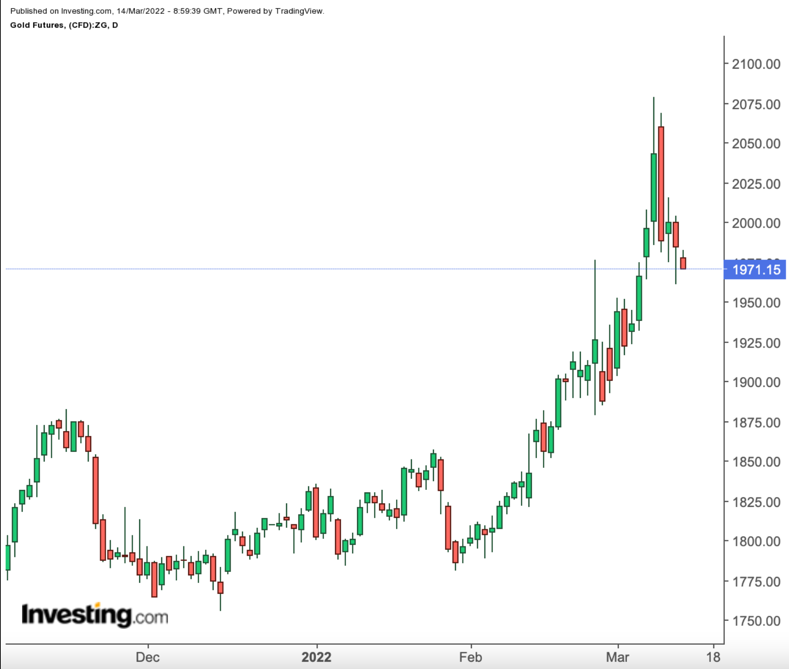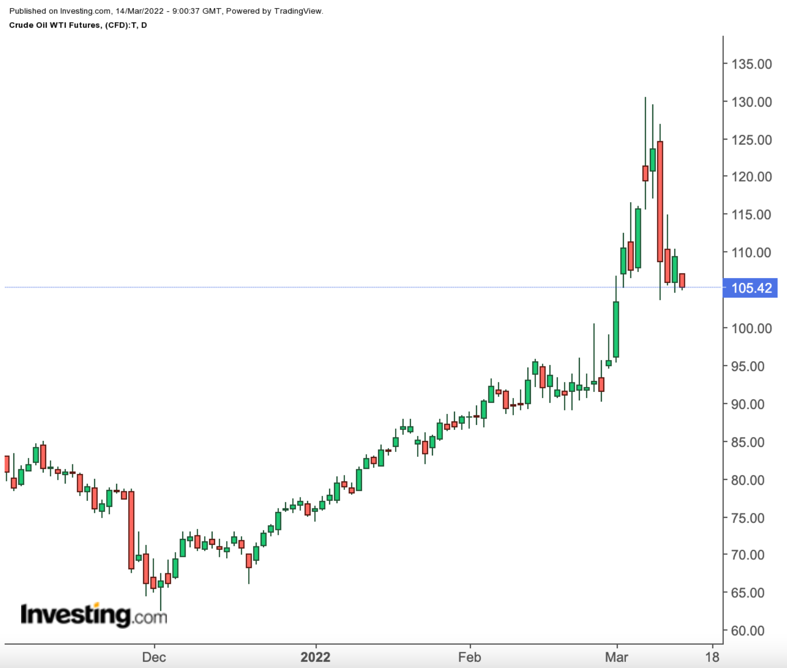The risk of an escalation or easing of the war in Ukraine, along with the off chance the Federal Reserve might double down on its first pandemic-era rate hike, is keeping oil and gold markets on tenterhooks as the week opens.
Oil prices extended last week's decline to fall more than 2% in early Asian trade on Monday after a US official said Russia was showing signs it might be willing to have substantive negotiations over Ukraine.

By 1:30 AM in New York (1:30 PM Singapore), Brent, the global benchmark for oil, was down $2.53, or 2.3%, to $110.14 per barrel.
US crude’s West Texas Intermediate benchmark fell $2.98, or 2.7%, to $106.35.
“Rejection at the resistance levels of … $116-$120 may push WTI down again to $103,” warned Sunil Kumar Dixit, chief technical strategist at skcharting.com.
“Breaking and sustaining below these levels can expose oil to the $95 and $86 areas, which may be fair value sans risk premia.”
Last week, Brent lost 4.8% while US crude fell 5.7%, posting their steepest weekly declines since November. That was after both contracts hit their highest levels since 2008 earlier in the week on supply concerns after the US and European allies considered banning Russian oil imports.
While the US later announced a ban on Russian oil imports and Britain said it would phase them out by year-end, downward pressure on prices was fueled by comments from an ambassador of the United Arab Emirates (UAE), the No. 2 oil producer in OPEC, supporting production increases and encouraging the group to consider higher output.
UAE’s Energy Ministry later recanted the ambassador’s remarks, saying it would honor the production pact between OPEC+ alliance, which is made up of the 13-member Saudi-led OPEC and 10 other oil-producing countries steered by Russia
Since the COVID-19 pandemic peak, which sent WTI to minus $40 per barrel, OPEC+ has deliberately kept the market undersupplied, while struggling to hike production even on those occasions it wanted to, due to a lack of investments.
"The U.S. ban on Russian crude oil imports saw prices initially rally sharply. However, without the Europeans joining the move, the risk of further tightness in oil markets was discounted," analysts at ANZ Research said in a note quoted by Reuters on Monday.
Focus On Russia-Ukraine Talks
Talks between Russia and Ukraine are not taking place right now but will continue on Monday, Kremlin spokesperson Dmitry Peskov was quoted as saying on Sunday by the RIA news agency.
This was despite a barrage of Russian missiles hitting Ukraine's Yavoriv International Center for Peacekeeping and Security, a base just 15 miles (25 km) from the Polish border that has previously hosted NATO military instructors, killing 35 people and wounding 134, a Ukrainian official said.
The US, which had watched Russia's build-up on Ukraine's borders with mounting alarm for weeks, says it was a premeditated, unjustified, and unlawful "war of choice." In a telephone call, US President Joseph Biden and France's President, Emmanuel Macron underscored their commitment to holding Russia accountable for the invasion, the White House said.
The most-active gold futures contract on New York’s COMEX, April, was down $8.10, or 0.4%, at $1,976.90 an ounce.
Spot gold fell $15.34, or 0.8%, to $1,973.21.
Weakness below $1,985-$1,980 could push toward a retest of last week’s $1,958 level, said Dixit of skcharting.com.
Both the futures and spot markets for gold rose almost 1% last week.
In Monday morning’s trade in Asia, gold was down as US Treasury yields rose over expectations of a Fed rate hike. Hopes for a better outcome to the forthcoming talks in Ukraine also dented the safe-haven prospects for the yellow metal.
"Given the fact that both sides are willing to talk, I think the worst of the Ukraine crisis is probably behind us,” DailyFX strategist Margaret Yang told Reuters. “It's unlikely that gold price(s) will surge beyond the previous high from last week or reach a record high anytime soon."
The market also “seems to be pricing in the US Federal Reserve meeting on Wednesday. So this is a negative factor for gold," Yang added.
Fed Needs To Be Super Careful With Its Rate Hikes
The Fed’s test will be to curb inflation running at 40-year highs by raising interest rates just enough to cool demand—and not to kill it or send the economy into a recession.
It’s not that the central bank hasn’t done it before. A quarter-century ago, Alan Greenspan—arguably the most iconic Fed chair ever—pulled off such a soft landing in 1994-1995 with a combination of stiff and moderate rate hikes to crush inflationary pressures, although the bond market crashed and Wall Street tanked.
The problem for current chair Jerome Powell is that the feat has been made remarkably more difficult by Russia’s invasion of Ukraine.
The war, as Bloomberg noted in a commentary last week, has unleashed such turbulence in global financial and energy markets that will be hard to suppress, regardless of the tools in the Fed’s kit—whose remarkable powers the Chair never fails to remind us of at each monthly news conference.
“It’s going to be very tricky,” Moody’s Analytics Chief Economist Mark Zandi was quoted saying, pointing to rising energy bills—along with slumping stock and credit markets—that could also sap consumer demand, increasing the chances of a recession.
“The economic plane is coming into the tarmac at a very high rate of speed, buffeted by severe crosswinds from the pandemic, with a lot of fog created by uncertainty due to geopolitical events,” Zandi said, breaking down the landing metaphor used by Bloomberg.
“A 25 basis points rate hike at the March meeting would be a no decision as opposed to a decision … and it’s not going pull the handbrake on the inflation momentum that arguably is being further fueled (by the Russia-Ukraine conflict)," Johan Grahn, head of ETF Strategy at Allianz, told Investing.com.
Initially winning praise for the Fed’s quick stimulus action that helped prevent the COVID‑19 recession from turning into an outright depression, Powell is now the poster-boy for everything gone wrong with inflation—especially after his admission that the central bank had totally misread the problem as being transitory.
On top of a maximum of seven rate hikes this year—as per the number of FOMC calendar meetings—there is a yet-to-be-specified reduction in the Fed’s balance sheet, which now stands at $8.9 trillion after the central bank loaded up on Treasuries and mortgage-backed securities to support the economy since the outbreak of COVID-19 in March 2020.
That action will reduce cash in the financial system—but it will also bring uncertain consequences for bond and stock markets. The danger is that if inflation doesn’t begin to subside in response to these initial moves, policymakers will end up raising rates too high, sending the economy into a recession and financial markets into a slump.
“When you’re wrong in one direction and you’re painfully wrong, you’re going to have to end up with too much heavy lifting to go in the other direction,” former Fed Governor Lawrence Lindsey was quoted saying by Bloomberg, as he puts the odds of a downturn by the end of 2023 at above 50%.
To recap: a 25 bps, or quarter percentage point hike is expected to cause little or no turbulence across markets next week, and possibly embolden further risk-takers in stocks to bonds, forex, and commodities.
A 50 bps, or half percentage point hike will have some serious consequences, with gold, possibly even oil, plummeting amid renewed crash on Wall Street. Inflation could pause briefly too—but the Fed certainly needs to do more if it doesn’t want any subdued price pressure to come roaring back.
Disclaimer: Barani Krishnan uses a range of views outside his own to bring diversity to his analysis of any market. For neutrality, he sometimes presents contrarian views and market variables. He does not hold a position in the commodities and securities he writes about.
Which stock should you buy in your very next trade?
With valuations skyrocketing in 2024, many investors are uneasy putting more money into stocks. Unsure where to invest next? Get access to our proven portfolios and discover high-potential opportunities.
In 2024 alone, ProPicks AI identified 2 stocks that surged over 150%, 4 additional stocks that leaped over 30%, and 3 more that climbed over 25%. That's an impressive track record.
With portfolios tailored for Dow stocks, S&P stocks, Tech stocks, and Mid Cap stocks, you can explore various wealth-building strategies.
